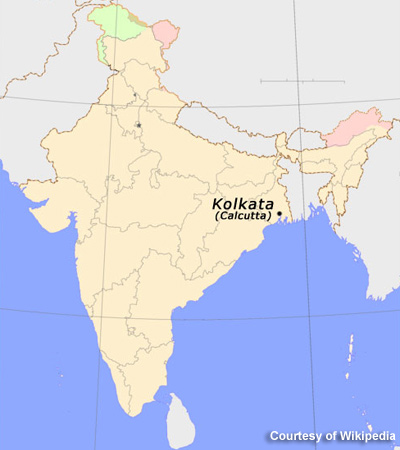Kolkata (Calcutta)
CALCUTTA, RECENTLY renamed Kolkata after its original village site of Kolikata and an on-site temple of goddess Kali, was founded by Job Charnock in 1690 on behalf of the British East India Company. The same location in northwestern INDIA was also a Portuguese and Dutch encampment site during the mid-17th century. It is, however the British encampment that started the impetus to develop the area as a trading center that eventually formed the core of a huge Calcutta metropolis leading to the evolution of a 50-mi- (80-km-) long linear conurbation (continuous urban agglomeration) along the Hughly (Hooghly) river.
Calcutta was the capital of British India (1757–1911) and thereafter it was relegated to the capital of the undivided Bengal Province. It has been the capital of the state of West Bengal since 1947. The Calcutta Metropolitan District was formed in 1961 as a planning unit for the entire conurbation. It consists of over 500 administrative units, including the two largest cities: corporations of Kolkata and its twin city of Haora (Hawrah).

Only 1 degree south of TROPIC OF CANCER, Kolkata falls in the monsoon climatic regime with most of its annual average rainfall of 64 in (162 cm) falling in the four-month period of June through September. Its January temperature average is 67 degrees F (19 degrees C), while July averages 85 degrees F (29 degrees C).
The British established a port, Fort Williams, and an initial water transport network to connect the city with an extensive HINTERLAND that contained the richest agricultural and mineral resource region of India. An extensive railroad network was developed in 1850s. Using the hinterland, Calcutta became the primary manufacturing center of India specializing in jute textiles, paper mills, heavy engineering, and rubber. By 1921, 35 percent of India's industrial workers were based in Calcutta.
Calcutta's economy stagnated in the 1970s because of the antipathy of both domestic and foreign investors in the face of labor union agitation and the Marxist West Bengal state government's anti-capitalist rhetoric. However, Calcutta was the pacesetter for the country for political, educational, and economic leadership. In recent years, Calcutta's importance has been displaced by MUMBAI, the population of which in 2000 was 16 million, in comparison to Calcutta's 13 million.
Nonetheless, Calcutta remains the second-largest metropolis of India; its world rank stands at seventh. The City of Calcutta, the main hub of the metropolis, has one of the highest densities of population, over 62,000 people per square mi (24,000 per square km); one out of every three lives in slums; and the rich/poor contrast in housing is very vivid. Hindus constitute 83 percent of city population and Muslims make up 14 percent. The remaining 3 percent are Christians, Jains, and Sikhs. The city has high linguistic diversity.
The port of Calcutta was the leading export and import center of the country during the 19th and most of the 20th century. It has lost its position to Mumbai. Calcutta is the home of the Calcutta (1857) and Jadavpur (1955) universities. Four Nobel laureates are associated with the city. Rabindranath Tagore had his home here; Mother Teresa did social work and lived here; C.B. Raman worked and researched here; Amartya Sen studied, taught, researched, and lived here, too.
Kolkata, jammed with a combination of vehicles, automobiles, buses, trains, hand-pulled carts, and thousands of pedestrians, introduced a 10.2-mile (16.4-km) long subway system in 1984. The subway, which is being extended farther south and north, carries 25 percent of the commuters.